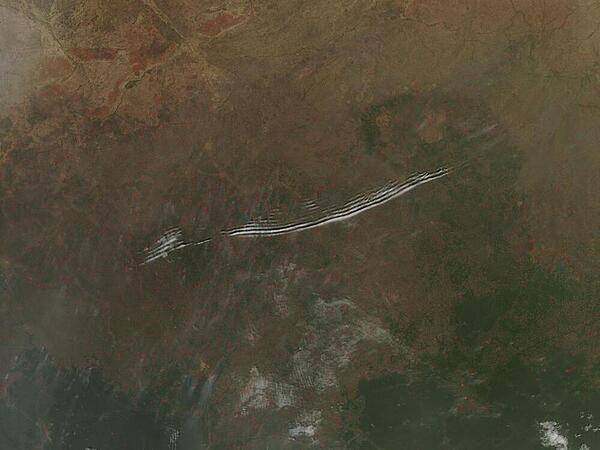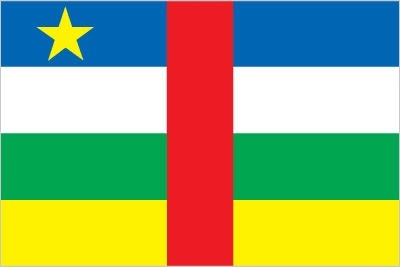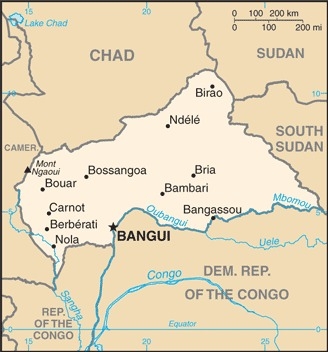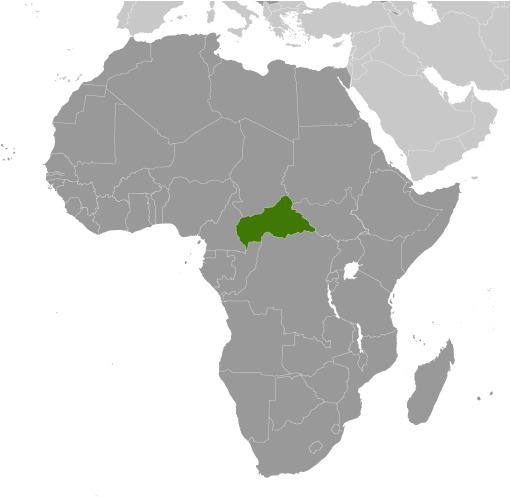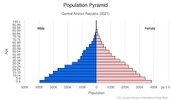Central African Republic
Introduction
Background
The Central African Republic (CAR) is a perennially weak state that sits at the crossroads of ethnic and linguistic groups in the center of the African continent. Among the last areas of sub-Saharan Africa to be drawn into the world economy, its introduction into trade networks around the early 1700s fostered significant competition among its population. The local population sought to benefit from the lucrative Atlantic, trans-Saharan, and Indian Ocean trade in enslaved people and ivory. Slave raids aided by representatives from the local populations fostered animosity between ethnic groups that remains today. The territory was established as a French colony named Ubangui-Shari in 1903, and France modeled its administration of the colony after the Belgian Congo, subcontracting control of the territory to private companies that collected rubber and ivory. Although France banned the domestic slave trade in CAR in the 1910s, the private companies continued to exploit the population through forced labor. The colony of Ubangi-Shari gained independence from France as the Central African Republic in August 1960, but the death of independence leader Barthelemy BOGANDA six months prior led to an immediate struggle for power.
CAR’s political history has since been marred by a series of coups, the first of which brought Jean-Bedel BOKASSA to power in 1966. BOKASSA’s regime was characterized by widespread corruption and an intolerance of opposition, which manifested in the disappearances of many who challenged BOKASSA’s rule. In an effort to prolong his mandate, he named himself emperor in 1976 and changed the country’s name to the Central African Empire. His regime’s economic mismanagement culminated in widespread student protests in early 1979 that were violently suppressed by security forces. BOKASSA, rumored to have participated in the killing of some young students after the protests, fell out of favor with the international community and was overthrown in a French-backed coup in 1979. After BOKASSA’s departure, the country’s name once again became the Central African Republic.
CAR’s fifth coup in March 2013 unseated President Francois BOZIZE after a mainly Muslim rebel coalition named the Seleka seized the capital and forced BOZIZE, who himself had taken power in a coup in 2003, to flee the country. Widespread abuses by the Seleka spurred the formation of mainly Christian self-defense groups that called themselves the anti-Balaka, which have also committed human rights abuses against Muslim populations in retaliation. Since the rise of the self-defense groups, conflict in CAR has become increasingly ethnoreligious-based, although focused on identity as opposed to religious ideology. Elections organized by a transitional government in early 2016 installed independent candidate Faustin-Archange TOUADERA as president; he was reelected in December 2020. A peace agreement signed in February 2019 between the government and the main armed factions has had little effect, and armed groups remain in control of large swaths of the country's territory.
Visit the Definitions and Notes page to view a description of each topic.
Geography
Location
Central Africa, north of Democratic Republic of the Congo
Geographic coordinates
7 00 N, 21 00 E
Map references
Africa
Land boundaries
total: 5,920 km
border countries (6): Cameroon 901 km, Chad 1556 km, Democratic Republic of the Congo 1747 km, Republic of the Congo 487 km, South Sudan 1055 km, Sudan 174 km
Coastline
0 km (landlocked)
Maritime claims
none (landlocked)
Climate
tropical; hot, dry winters; mild to hot, wet summers
Terrain
vast, flat to rolling plateau; scattered hills in northeast and southwest
Elevation
highest point: Mont Ngaoui 1,410 m
lowest point: Oubangui River 335 m
mean elevation: 635 m
Natural resources
diamonds, uranium, timber, gold, oil, hydropower
Land use
agricultural land: 8.1% (2018 est.)
arable land: 2.9% (2018 est.)
permanent crops: 0.1% (2018 est.)
permanent pasture: 5.1% (2018 est.)
forest: 36.2% (2018 est.)
other: 55.7% (2018 est.)
Irrigated land
10 sq km (2012)
Major watersheds (area sq km)
Atlantic Ocean drainage: Congo (3,730,881 sq km), (Mediterranean Sea) Nile (3,254,853 sq km)
Internal (endorheic basin) drainage: Lake Chad (2,497,738 sq km)
Major aquifers
Congo Basin, Lake Chad Basin
Major rivers (by length in km)
Ubangi river source (shared with Democratic Republic of Congo and Republic of Congo [m]) - 2,270 km
note – [s] after country name indicates river source; [m] after country name indicates river mouth
Population distribution
majority of residents live in the western and central areas of the country, especially in and around the capital of Bangui as shown in this population distribution map
Natural hazards
hot, dry, dusty harmattan winds affect northern areas; floods are common
Geography - note
landlocked; almost the precise center of Africa
People and Society
Population
5,357,984 (July 2021 est.)
note: estimates for this country explicitly take into account the effects of excess mortality due to AIDS; this can result in lower life expectancy, higher infant mortality, higher death rates, lower population growth rates, and changes in the distribution of population by age and sex than would otherwise be expected
Nationality
noun: Central African(s)
adjective: Central African
Ethnic groups
Baya 28.8%, Banda 22.9%, Mandjia 9.9%, Sara 7.9%, M'Baka-Bantu 7.9%, Arab-Fulani (Peul) 6%, Mbum 6%, Ngbanki 5.5%, Zande-Nzakara 3%, other Central African Republic ethnic groups 2%, non-Central African Republic ethnic groups .1% (2003 est.)
Languages
French (official), Sangho (lingua franca and national language), tribal languages
Religions
Christian 89%, Muslim 9%, folk religion 1%, unaffiliated 1% (2020 est.)
note: animistic beliefs and practices strongly influence the Christian majority
Demographic profile
The Central African Republic’s (CAR) humanitarian crisis has worsened since a coup in March 2013. CAR’s high mortality rate and low life expectancy are attributed to elevated rates of preventable and treatable diseases (including malaria and malnutrition), an inadequate health care system, precarious food security, and armed conflict. Some of the worst mortality rates are in western CAR’s diamond mining region, which is impoverished because of government attempts to control the diamond trade and the fall in industrial diamond prices. To make matters worse, the government and international donors have reduced health funding in recent years. The CAR’s weak educational system and low literacy rate have also suffered as a result of the country’s ongoing conflict. Schools are closed, qualified teachers are scarce, infrastructure, funding, and supplies are lacking and subject to looting, and many students and teachers are displaced by violence.
Rampant poverty, human rights violations, unemployment, poor infrastructure, and a lack of security and stability have led to forced displacement internally and externally. Since the political crisis that resulted in CAR’s March 2013 coup began in December 2012, approximately 600,000 people have fled to Chad, the Democratic Republic of the Congo (DRC), and other neighboring countries, while another estimated 600,000 are displaced internally as of October 2019. The UN has urged countries to refrain from repatriating CAR refugees amid the heightened lawlessness.
(2019)Age structure
0-14 years: 39.49% (male 1,188,682/female 1,176,958)
15-24 years: 19.89% (male 598,567/female 593,075)
25-54 years: 32.95% (male 988,077/female 986,019)
55-64 years: 4.32% (male 123,895/female 134,829)
65 years and over: 3.35% (male 78,017/female 122,736) (2020 est.)
Dependency ratios
total dependency ratio: 86.4
youth dependency ratio: 81.1
elderly dependency ratio: 5.2
potential support ratio: 19.2 (2020 est.)
Median age
total: 20 years
male: 19.7 years
female: 20.3 years (2020 est.)
Population distribution
majority of residents live in the western and central areas of the country, especially in and around the capital of Bangui as shown in this population distribution map
Urbanization
urban population: 42.6% of total population (2021)
rate of urbanization: 3.32% annual rate of change (2020-25 est.)
Major urban areas - population
910,000 BANGUI (capital) (2021)
Sex ratio
at birth: 1.03 male(s)/female
0-14 years: 1.01 male(s)/female
15-24 years: 1.01 male(s)/female
25-54 years: 1 male(s)/female
55-64 years: 0.92 male(s)/female
65 years and over: 0.64 male(s)/female
total population: 0.99 male(s)/female (2020 est.)
Maternal mortality ratio
829 deaths/100,000 live births (2017 est.)
country comparison to the world: 5Infant mortality rate
total: 84.22 deaths/1,000 live births
male: 90.39 deaths/1,000 live births
female: 77.86 deaths/1,000 live births (2021 est.)
Life expectancy at birth
total population: 55.07 years
male: 53.74 years
female: 56.44 years (2021 est.)
Contraceptive prevalence rate
17.8% (2019)
Drinking water source
improved: urban: 89.6% of population
rural: 54.4% of population
total: 68.5% of population
unimproved: urban: 10.4% of population
rural: 45.6% of population
total: 31.5% of population (2015 est.)
Current Health Expenditure
11% (2018)
Physicians density
0.07 physicians/1,000 population (2015)
Hospital bed density
1 beds/1,000 population (2011)
Sanitation facility access
improved: urban: 43.6% of population
rural: 7.2% of population
total: 21.8% of population
unimproved: urban: 56.4% of population
rural: 92.8% of population
total: 78.2% of population (2015 est.)
Major infectious diseases
degree of risk: very high (2020)
food or waterborne diseases: bacterial and protozoal diarrhea, hepatitis A and E, and typhoid fever
vectorborne diseases: malaria and dengue fever
water contact diseases: schistosomiasis
animal contact diseases: rabies
respiratory diseases: meningococcal meningitis
Literacy
definition: age 15 and over can read and write
total population: 37.4%
male: 49.5%
female: 25.8% (2018)
School life expectancy (primary to tertiary education)
total: 7 years
male: 8 years
female: 6 years (2012)
Environment
Environment - current issues
water pollution; tap water is not potable; poaching and mismanagement have diminished the country's reputation as one of the last great wildlife refuges; desertification; deforestation; soil erosion
Environment - international agreements
party to: Biodiversity, Climate Change, Climate Change-Kyoto Protocol, Climate Change-Paris Agreement, Comprehensive Nuclear Test Ban, Desertification, Endangered Species, Hazardous Wastes, Nuclear Test Ban, Ozone Layer Protection, Tropical Timber 2006, Wetlands
signed, but not ratified: Law of the Sea
Air pollutants
particulate matter emissions: 49.5 micrograms per cubic meter (2016 est.)
carbon dioxide emissions: 0.3 megatons (2016 est.)
methane emissions: 22.44 megatons (2020 est.)
Climate
tropical; hot, dry winters; mild to hot, wet summers
Land use
agricultural land: 8.1% (2018 est.)
arable land: 2.9% (2018 est.)
permanent crops: 0.1% (2018 est.)
permanent pasture: 5.1% (2018 est.)
forest: 36.2% (2018 est.)
other: 55.7% (2018 est.)
Urbanization
urban population: 42.6% of total population (2021)
rate of urbanization: 3.32% annual rate of change (2020-25 est.)
Revenue from forest resources
forest revenues: 8.99% of GDP (2018 est.)
country comparison to the world: 5Major infectious diseases
degree of risk: very high (2020)
food or waterborne diseases: bacterial and protozoal diarrhea, hepatitis A and E, and typhoid fever
vectorborne diseases: malaria and dengue fever
water contact diseases: schistosomiasis
animal contact diseases: rabies
respiratory diseases: meningococcal meningitis
Food insecurity
exceptional shortfall in aggregate food production/supplies: due to conflict and population displacements - ongoing conflicts and population displacements due to armed violence that followed the December 2020 elections, adding to the already high levels of civil insecurity, coupled with restrictive measures to control the COVID‑19 pandemic, are expected to continue affecting agricultural activities and limit farmers’ access to crop‑growing areas and inputs, with a negative impact on 2021 crop production (2021)
Waste and recycling
municipal solid waste generated annually: 1,105,983 tons (2014 est.)
Major rivers (by length in km)
Ubangi river source (shared with Democratic Republic of Congo and Republic of Congo [m]) - 2,270 km
note – [s] after country name indicates river source; [m] after country name indicates river mouth
Major watersheds (area sq km)
Atlantic Ocean drainage: Congo (3,730,881 sq km), (Mediterranean Sea) Nile (3,254,853 sq km)
Internal (endorheic basin) drainage: Lake Chad (2,497,738 sq km)
Major aquifers
Congo Basin, Lake Chad Basin
Total water withdrawal
municipal: 60.1 million cubic meters (2017 est.)
industrial: 12 million cubic meters (2017 est.)
agricultural: 400,000 cubic meters (2017 est.)
Total renewable water resources
141 billion cubic meters (2017 est.)
Government
Country name
conventional long form: Central African Republic
conventional short form: none
local long form: Republique Centrafricaine
local short form: none
former: Ubangi-Shari, Central African Empire
abbreviation: CAR
etymology: self-descriptive name specifying the country's location on the continent; "Africa" is derived from the Roman designation of the area corresponding to present-day Tunisia "Africa terra," which meant "Land of the Afri" (the tribe resident in that area), but which eventually came to mean the entire continent
Government type
presidential republic
Capital
name: Bangui
geographic coordinates: 4 22 N, 18 35 E
time difference: UTC+1 (6 hours ahead of Washington, DC, during Standard Time)
etymology: established as a French settlement in 1889 and named after its location on the northern bank of the Ubangi River; the Ubangi itself was named from the native word for the "rapids" located beside the outpost, which marked the end of navigable water north from from Brazzaville
Administrative divisions
14 prefectures (prefectures, singular - prefecture), 2 economic prefectures* (prefectures economiques, singular - prefecture economique), and 1 commune**; Bamingui-Bangoran, Bangui**, Basse-Kotto, Haute-Kotto, Haut-Mbomou, Kemo, Lobaye, Mambere-Kadei, Mbomou, Nana-Grebizi*, Nana-Mambere, Ombella-Mpoko, Ouaka, Ouham, Ouham-Pende, Sangha-Mbaere*, Vakaga
Independence
13 August 1960 (from France)
National holiday
Republic Day, 1 December (1958)
Constitution
history: several previous; latest (interim constitution) approved by the Transitional Council 30 August 2015, adopted by referendum 13-14 December 2015, ratified 27 March 2016
amendments: proposals require support of the government, two thirds of the National Council of Transition, and assent by the "Mediator of the Central African" crisis; passage requires at least three-fourths majority vote by the National Council membership; non-amendable constitutional provisions include those on the secular and republican form of government, fundamental rights and freedoms, amendment procedures, or changes to the authorities of various high-level executive, parliamentary, and judicial officials
Legal system
civil law system based on the French model
International law organization participation
has not submitted an ICJ jurisdiction declaration; accepts ICCt jurisdiction
Citizenship
citizenship by birth: no
citizenship by descent only: least one parent must be a citizen of the Central African Republic
dual citizenship recognized: yes
residency requirement for naturalization: 35 years
Suffrage
18 years of age; universal
Executive branch
chief of state: President Faustin-Archange TOUADERA (since 30 March 2016; reelected 27 December 2020)
head of government: Prime Minister Henri-Marie DONDRA (since 11 June 2021); note - Prime Minister Firmin NGREBADA resigned on 10 June 2021
cabinet: Council of Ministers appointed by the president
elections/appointments: under the 2015 constitution, the president is elected by universal direct suffrage for a period of 5 years (eligible for a second term); election last held 27 December 2020 (next to be held in December 2025); note - Central African Republic held presidential and partial legislative elections on December 27, 2020; voting was disrupted in some areas, so those constituencies held the first round of their legislative elections on March 14, 2021; some of the constituencies that did vote on December 27, 2020 held runoff elections for their legislators.
election results: Faustin-Archange TOUADERA reelected president in first round; percent of vote - Faustin-Archange TOUADERA (independent) 59.3%, Anicet Georges DOLOGUELE (URCA) 21%, other 19.7%
note: rebel forces seized the capital in March 2013, forcing former President BOZIZE to flee the country; Interim President Michel DJOTODIA assumed the presidency, reinstated the prime minister, and established a National Transitional Council (CNT) in April 2013; the NTC elected Catherine SAMBA-PANZA interim president in January 2014 to serve until February 2015, when new elections were to be held; her term was extended because instability delayed new elections and the transition did not take place until the end of March 2016
Legislative branch
description: unicameral National Assembly or Assemblee Nationale (140 seats; members directly elected in single-seat constituencies by absolute majority vote with a second round if needed; members serve 5-year terms)
elections: first round last held on 27 December 2020; note - on election day, voting in many electoral areas was disrupted by armed groups; on 13 February 2021, President TOUADERA announced that a new first round of elections will be held on 27 February for those areas controlled by armed groups and and second round on 14 March
election results: December 2015 election: percent of vote by party - NA; seats by party - UNDP 16, URCA 11, RDC 8, MLPC 10, KNK 7, other 28, independent 60; composition - men 129, women 11, percent of women 7.9%
Judicial branch
highest courts: Supreme Court or Cour Supreme (consists of NA judges); Constitutional Court (consists of 9 judges, at least 3 of whom are women)
judge selection and term of office: Supreme Court judges appointed by the president; Constitutional Court judge appointments - 2 by the president, 1 by the speaker of the National Assembly, 2 elected by their peers, 2 are advocates elected by their peers, and 2 are law professors elected by their peers; judges serve 7-year non-renewable terms
subordinate courts: high courts; magistrates' courts
Political parties and leaders
Action Party for Development or PAD [El Hadj Laurent NGON-BABA]
Alliance for Democracy and Progress or ADP [Clement BELIBANGA]
Central African Democratic Rally or RDC [Desire Nzanga KOLINGBA]
Movement for Democracy and Development or MDD [Louis PAPENIAH]
Movement for the Liberation of the Central African People or MLPC [Martin ZIGUELE]
National Convergence (also known as Kwa Na Kwa) or KNK [Francois BOZIZE]
National Union for Democracy and Progress or UNDP [Amine MICHEL]
New Alliance for Progress or NAP [Jean-Jacques DEMAFOUTH]
Social Democratic Party or PSD [Enoch LAKOUE]
Union for Central African Renewal or URCA [Anicet-Georges DOLOGUELE]
International organization participation
ACP, AfDB, AU, BDEAC, CEMAC, EITI (compliant country) (suspended), FAO, FZ, G-77, IAEA, IBRD, ICAO, ICCt, ICRM, IDA, IFAD, IFC, IFRCS, ILO, IMF, Interpol, IOC, IOM, ITSO, ITU, ITUC (NGOs), MIGA, NAM, OIC (observer), OIF, OPCW, UN, UNCTAD, UNESCO, UNIDO, UNWTO, UPU, WCO, WHO, WIPO, WMO, WTO
Diplomatic representation in the US
chief of mission: Ambassador Martial NDOUBOU (since 17 September 2018)
chancery: 2704 Ontario Road NW, Washington, DC 20009
telephone: [1] (202) 483-7800
FAX: [1] (202) 332-9893
email address and website:
pc@usrcaembassy.org
https://www.usrcaembassy.org/
Diplomatic representation from the US
chief of mission: Ambassador Lucy TAMLYN (since 11 January 2019)
embassy: Avenue David Dacko, Bangui
mailing address: 2060 Bangui Place, Washington DC 20521-2060
telephone: [236] 2161-0200
FAX: [236] 2161-4494
email address and website:
https://cf.usembassy.gov/
Flag description
four equal horizontal bands of blue (top), white, green, and yellow with a vertical red band in center; a yellow five-pointed star to the hoist side of the blue band; banner combines the Pan-African and French flag colors; red symbolizes the blood spilled in the struggle for independence, blue represents the sky and freedom, white peace and dignity, green hope and faith, and yellow tolerance; the star represents aspiration towards a vibrant future
National symbol(s)
elephant; national colors: blue, white, green, yellow, red
National anthem
name: "Le Renaissance" (The Renaissance)
lyrics/music: Barthelemy BOGANDA/Herbert PEPPER
note: adopted 1960; Barthelemy BOGANDA wrote the anthem's lyrics and was the first prime minister of the autonomous French territory
Economy
Economic overview
Subsistence agriculture, together with forestry and mining, remains the backbone of the economy of the Central African Republic (CAR), with about 60% of the population living in outlying areas. The agricultural sector generates more than half of estimated GDP, although statistics are unreliable in the conflict-prone country. Timber and diamonds account for most export earnings, followed by cotton. Important constraints to economic development include the CAR's landlocked geography, poor transportation system, largely unskilled work force, and legacy of misdirected macroeconomic policies. Factional fighting between the government and its opponents remains a drag on economic revitalization. Distribution of income is highly unequal and grants from the international community can only partially meet humanitarian needs. CAR shares a common currency with the Central African Monetary Union. The currency is pegged to the Euro.
Since 2009, the IMF has worked closely with the government to institute reforms that have resulted in some improvement in budget transparency, but other problems remain. The government's additional spending in the run-up to the 2011 election worsened CAR's fiscal situation. In 2012, the World Bank approved $125 million in funding for transport infrastructure and regional trade, focused on the route between CAR's capital and the port of Douala in Cameroon. In July 2016, the IMF approved a three-year extended credit facility valued at $116 million; in mid-2017, the IMF completed a review of CAR’s fiscal performance and broadly approved of the government’s management, although issues with revenue collection, weak government capacity, and transparency remain. The World Bank in late 2016 approved a $20 million grant to restore basic fiscal management, improve transparency, and assist with economic recovery.
Participation in the Kimberley Process, a commitment to remove conflict diamonds from the global supply chain, led to a partially lifted the ban on diamond exports from CAR in 2015, but persistent insecurity is likely to constrain real GDP growth.
Real GDP (purchasing power parity)
$4.483 billion (2019 est.)
$4.354 billion (2018 est.)
$4.195 billion (2017 est.)
note: data are in 2017 dollars
Real GDP growth rate
4.3% (2017 est.)
4.5% (2016 est.)
4.8% (2015 est.)
Real GDP per capita
$900 note: data are in 2017 dollars (2020 est.)
$900 note: data are in 2017 dollars (2019 est.)
$900 note: data are in 2017 dollars (2018 est.)
note: data are in 2017 dollars
GDP (official exchange rate)
$1.937 billion (2017 est.)
Inflation rate (consumer prices)
2.7% (2019 est.)
1.6% (2018 est.)
4.2% (2017 est.)
GDP - composition, by sector of origin
agriculture: 43.2% (2017 est.)
industry: 16% (2017 est.)
services: 40.8% (2017 est.)
GDP - composition, by end use
household consumption: 95.3% (2017 est.)
government consumption: 8.5% (2017 est.)
investment in fixed capital: 13.7% (2017 est.)
investment in inventories: 0% (2017 est.)
exports of goods and services: 12% (2017 est.)
imports of goods and services: -29.5% (2017 est.)
Agricultural products
cassava, yams, groundnuts, taro, bananas, sugar cane, beef, maize, plantains, milk
Industries
gold and diamond mining, logging, brewing, sugar refining
Population below poverty line
62% NA (2008 est.)
Gini Index coefficient - distribution of family income
43.6 (2003 est.)
61.3 (1993)
Household income or consumption by percentage share
lowest 10%: 2.1%
highest 10%: 33% (2003)
Budget
revenues: 282.9 million (2017 est.)
expenditures: 300.1 million (2017 est.)
Fiscal year
calendar year
Current account balance
-$163 million (2017 est.)
-$97 million (2016 est.)
Exports - partners
China 41%, United Arab Emirates 19%, France 7% (2019)
Exports - commodities
lumber, gold, diamonds, sea vessels, cocoa paste (2019)
Imports - partners
India 18%, France 12%, United States 11%, China 9%, Netherlands 7%, Belgium 7%, Malta 6% (2019)
Imports - commodities
refined petroleum, packaged medicines, natural gas, broadcasting equipment, second-hand clothing (2019)
Reserves of foreign exchange and gold
$304.3 million (31 December 2017 est.)
$252.5 million (31 December 2016 est.)
Debt - external
$779.9 million (31 December 2017 est.)
$691.5 million (31 December 2016 est.)
Exchange rates
Cooperation Financiere en Afrique Centrale francs (XAF) per US dollar -
605.3 (2017 est.)
593.01 (2016 est.)
593.01 (2015 est.)
591.45 (2014 est.)
494.42 (2013 est.)
Energy
Electricity access
electrification - total population: 3% (2019)
electrification - urban areas: 7% (2019)
electrification - rural areas: 0.4% (2019)
Electricity - installed generating capacity
38,300 kW (2016 est.)
country comparison to the world: 196Electricity - from fossil fuels
50% of total installed capacity (2016 est.)
country comparison to the world: 151Electricity - from nuclear fuels
0% of total installed capacity (2017 est.)
country comparison to the world: 64Electricity - from hydroelectric plants
50% of total installed capacity (2017 est.)
country comparison to the world: 40Electricity - from other renewable sources
1% of total installed capacity (2017 est.)
country comparison to the world: 150Refined petroleum products - consumption
2,800 bbl/day (2016 est.)
country comparison to the world: 189Communications
Telephones - fixed lines
total subscriptions: 2,193 (2018)
subscriptions per 100 inhabitants: less than 1 (2018 est.)
Telephones - mobile cellular
total subscriptions: 1,595,294 (2019)
subscriptions per 100 inhabitants: 33.62 (2019 est.)
Telecommunication systems
general assessment: network consists principally of microwave radio relay and at low-capacity; ongoing conflict has obstructed telecommunication and media development, although there are ISP (Internet service providers) and mobile phone carriers, radio is the most-popular communications medium (2018)
domestic: very limited telephone service with less than 1 fixed-line connection per 100 persons; with the presence of multiple providers mobile-cellular service has reached 33 per 100 mobile-cellular subscribers; cellular usage is increasing from a low base; most fixed-line and mobile-cellular telephone services are concentrated in Bangui (2019)
international: country code - 236; satellite earth station - 1 Intelsat (Atlantic Ocean)
note: the COVID-19 pandemic continues to have a significant impact on production and supply chains globally; since 2020, some aspects of the telecom sector have experienced downturn, particularly in mobile device production; many network operators delayed upgrades to infrastructure; progress towards 5G implementation was postponed or slowed in some countries; consumer spending on telecom services and devices was affected by large-scale job losses and the consequent restriction on disposable incomes; the crucial nature of telecom services as a tool for work and school from home became evident, and received some support from governments
Broadcast media
government-owned network, Radiodiffusion Television Centrafricaine, provides limited domestic TV broadcasting; state-owned radio network is supplemented by a small number of privately owned broadcast stations as well as a few community radio stations; transmissions of at least 2 international broadcasters are available (2017)
Internet users
total: 557,100 (2021 est.)
percent of population: 4.34% (2019 est.)
Broadband - fixed subscriptions
total: 499 (2019)
subscriptions per 100 inhabitants: less than 1 (2019 est.)
Transportation
National air transport system
number of registered air carriers: 2 (2020)
inventory of registered aircraft operated by air carriers: 2
annual passenger traffic on registered air carriers: 46,364 (2015)
annual freight traffic on registered air carriers: 0 mt-km (2015)
Airports - with paved runways
total: 1
2,438 to 3,047 m: 1 (2019)
Airports - with unpaved runways
total: 37
2,438 to 3,047 m: 1
1,524 to 2,437 m: 11
914 to 1,523 m: 19
under 914 m: 6 (2013)
Roadways
total: 24,000 km (2018)
paved: 700 km (2018)
unpaved: 23,300 km (2018)
Waterways
2,800 km (the primary navigable river is the Ubangi, which joins the River Congo; it was the traditional route for the export of products because it connected with the Congo-Ocean railway at Brazzaville; because of the warfare on both sides of the River Congo from 1997, importers and exporters preferred routes through Cameroon) (2011)
country comparison to the world: 34Ports and terminals
river port(s): Bangui (Oubangui)
Nola (Sangha)
Military and Security
Military and security forces
Central African Armed Forces (Forces Armees Centrafricaines, FACA): Army (includes an air squadron, Escadrille Centrafricaine), General Directorate of Gendarmerie Inspection (DGIG); Ministry of Interior: National Police (2021)
note - in 2019-2021, CAR created three Mixed Special Security units (Unités Spéciales Mixtes de Sécurité or USMS), regionally based battalion-sized units comprised of about 40% government and 60% rebel soldiers that are intended to provide security along transportation corridors and at mining sites; the units are intended to be transitional in nature with a scheduled deployment time of two years
Military expenditures
1.8% of GDP (2020 est.)
1.5% of GDP (2019 est.)
1.4% of GDP (2018 est.)
1.4% of GDP (2017 est.)
1.5% of GDP (2016 est.)
Military and security service personnel strengths
information varies; approximately 10,000 active troops, including an air component of 100-200 and up to 2,000 Gendarmerie; approximately 2,000 Mixed Special Security Units (2021)
Military equipment inventories and acquisitions
the FACA is lightly and poorly armed with mostly outdated weapons; since 2010, it has received small amounts of second-hand equipment from China, Russia, and Ukraine (2021)
note - since 2013, CAR has been under a UNSC arms embargo; the embargo bans all supplies of arms and related materiel to the country except to the CAR security forces if approved in advance by the relevant UN Sanctions Committee
Military service age and obligation
18 years of age for military service; no conscription (2021)
Military - note
the 2013 coup resulted in the institutional collapse of the FACA; its forces were overwhelmed and forced to flee to neighboring countries; reportedly only 10% of the FACA returned after the coup, and it has struggled to rebuild in the years of instability since; the European Union, France, Russia, the UN, and the US are providing various levels of security assistance
in 2018, the UN Security Council approved Russian security assistance for the CAR to help train and advise FACA personnel, as well as transport them to operational areas, provide logistical support, and assist with medical evacuation; Russia sent private military contractors, and as of late 2021, there were reportedly as many as 2,300 providing assistance to the FACA, as well as performing other security roles such as guarding mines and government officials; some Russian contractors and the CAR forces they supported have been accused of carrying out indiscriminate killings, using excessive force against civilians, and looting
the UN Multidimensional Integrated Stabilization Mission in the Central African Republic (MINUSCA) has operated in the country since 2014; its peacekeeping mission includes providing security, protecting civilians, facilitating humanitarian assistance, disarming and demobilizing armed groups, and supporting the country’s fragile transitional government; in November 2019, the UN Security Council extended the mandate of the MINUSCA peacekeeping mission another year; as of August 2021, MINUSCA had about 15,000 total personnel
the European Union Training Mission in the Central African Republic (EUTM-RCA) has operated in the country since 2016; the EUTM-RCA contributes to the restructuring of the country's military and defense sector through advice, training, and educational programs; as of mid-2021, it had trained 4 territorial infantry battalions (Bataillon d’Infanterie Territorial) and 1 amphibious infantry battalion
Transnational Issues
Disputes - international
periodic skirmishes persist over water and grazing rights among related pastoral populations along the border with southern Sudan
Refugees and internally displaced persons
refugees (country of origin): 5,570 (Democratic Republic of Congo) (2021)
IDPs: 722,101 (clashes between army and rebel groups since 2005; tensions between ethnic groups) (2021)
